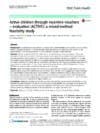Background
Adolescents face many barriers to physical activity, demonstrated by the decline in physical activity levels in teenage populations. This study aimed to assess the feasibility of overcoming such barriers via the implementation of an activity-promoting voucher scheme to teenagers in deprived areas.
Methods
All Year 9 pupils (n = 115; 13.3 ± 0.48 years; 51 % boys) from one secondary school in Wales (UK) participated. Participants received £25 of activity vouchers every month for six months for physical activity or sporting equipment. Focus groups (n = 7), with 43 pupils, and qualitative interviews with teachers (n = 2) were conducted to assess feasibility, in addition to a process evaluation utilising the RE-AIM framework. Quantitative outcomes at baseline, five months (during intervention) and twelve months (follow-up) included: physical activity (accelerometer), aerobic fitness (12 min Cooper run) and self-reported activity (PAQ-A). Motivation to exercise (BREQ-2) was measured three months post-baseline and at follow-up.
Results
Qualitative findings showed that vouchers encouraged friends to socialise through activity, provided opportunities to access local activities that pupils normally could not afford, and engaged both those interested and disinterested in physical education. Improvements in weekend moderate-to-vigorous physical activity and reductions in sedentary behaviour were observed in both sexes. Boys’ fitness significantly improved during the voucher scheme. ‘Non-active’ pupils (those not meeting recommended guidelines of 60 mins∙day−1) and those with higher motivation to exercise had higher voucher use.
Conclusions
Adolescents, teachers and activity providers supported the voucher scheme and felt the vouchers enabled deprived adolescents to access more physical activity opportunities. Voucher usage was associated with improved attitudes to physical activity, increased socialisation with friends and improved fitness and physical activity; presenting interesting avenues for further exploration in a larger intervention trial.



Responses